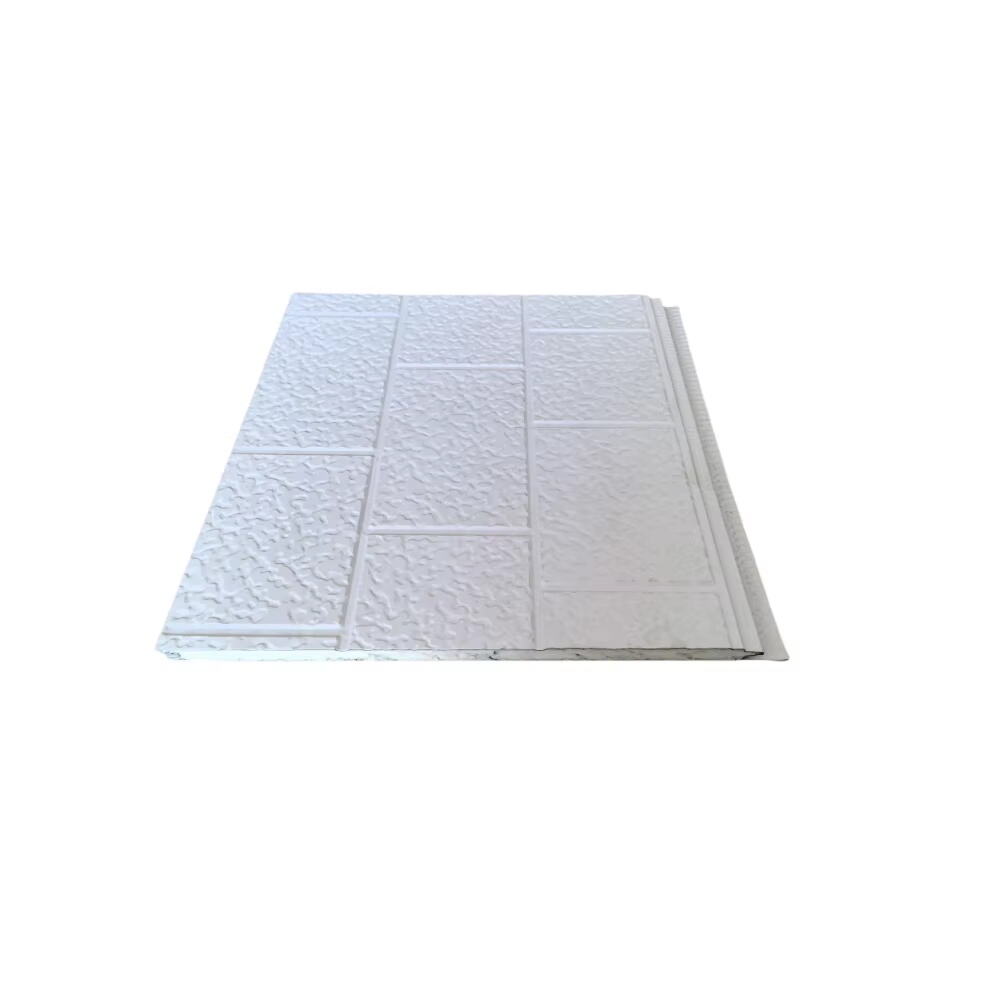Overview of Polyurethane Sandwich Panels in Modern Industry
Growing Demand in Industrial Construction
Polyurethane Sandwich Panels have seen a substantial rise in demand within industrial construction due to their exceptional insulation properties and contribution to building efficiency. These panels are becoming increasingly popular in industries such as cold storage, logistics, and other industrial facilities. According to Transparency Market Research, the global sandwich panels market, which includes Polyurethane Sandwich Panels, was valued at $16.06 billion in 2021 and is expected to reach $28.8 billion by 2031, indicating a robust compound annual growth rate (CAGR) of 6.3%.
The market's growth can be attributed to a shift towards sustainable building practices. Polyurethane Sandwich Panels meet the demands for eco-friendly materials as they provide superior energy efficiency, reducing the need for additional heating or cooling in buildings. This aligns perfectly with the global push for sustainability, drawing significant interest from architects and developers. As more industries and construction Projects prioritize sustainability, the role of these panels becomes increasingly crucial.
Core Components and Structural Design
Polyurethane Sandwich Panels are composed of a core and two rigid face sheets that enhance their durability and performance. Typically, the core is made of rigid polyurethane foam, though other materials like polyisocyanurate or phenolic foam may also be used depending on specific requirements for fire resistance or insulation efficiency. The core is sandwiched between metal facings, usually steel or aluminum, which contribute to the structural integrity and longevity of the panels.
The sandwich panel design offers remarkable structural advantages essential for industrial applications. This engineered design efficiently distributes load and enhances stability, making it ideal for environments demanding high structural performance. A study published in the Journal of Building Engineering underlined that the semi-rigid foam within the panels not only enhances load-bearing capacity but also improves energy efficiency by minimizing thermal bridging.
Moreover, engineering research confirms that properly designed core structures can significantly improve both durability and insulation capabilities. This makes polyurethane sandwich panels a preferred choice for industrial developers looking for a reliable, energy-efficient building solution that adheres to stringent regulatory standards while also offering sustainability and cost-effectiveness.
Polyurethane Core as a Thermal Barrier
Polyurethane sandwich panels are renowned for their exceptional thermal insulation properties, making them a superior choice compared to alternative insulating materials. The core of these panels, made from polyurethane, offers a high R-value, which is a measure of thermal resistance. According to experts, polyurethane cores can achieve R-values of up to 7 or more per inch, compared to around 3-4 for fiberglass insulation. This significant difference underscores the efficiency of polyurethane in minimizing heat transfer, ultimately leading to reduced energy consumption. Properly installed polyurethane cores can significantly lower heat loss, which directly translates into savings on heating and cooling costs.
Enhanced Durability in Harsh Industrial Environments
Resistance to Moisture and Corrosion
Polyurethane sandwich panels are renowned for their exceptional resistance to moisture and corrosion, making them ideal for humid environments. The closed-cell structure of the polyurethane foam core serves as an effective moisture barrier, preventing the growth of mold and mildew. This characteristic is particularly beneficial in industries where humidity levels are a concern, such as cold storage facilities. According to various industrial applications, using polyurethane sandwich panels in corrosive environments has significantly reduced maintenance costs. For instance, facilities using these panels have reported a decrease in corrosion-related repairs by up to 30% compared to traditional materials, highlighting the long-term durability benefits of these panels.
Fire Retardant Properties and Safety Compliance
Polyurethane sandwich panels incorporate fire-retardant additives that significantly enhance their safety profile. These additives are crucial in meeting safety compliance, as they help the panels meet stringent fire safety standards like those set by the National Fire Protection Association (NFPA). These panels often earn a Class A rating according to ASTM E84 standards, with flame spread indices below 25. Implementing panels with excellent fire resistance not only enhances safety for building occupants but also potentially lowers insurance costs due to their compliance with fire safety regulations. This dual advantage makes them an attractive choice for both industrial and commercial applications.
Longevity in Extreme Climates
The performance of polyurethane sandwich panels in extreme climates is consistent, maintaining their properties whether faced with intense heat or cold. These panels are designed with materials that withstand both temperature extremes, ensuring that the integrity and insulating capabilities of the panels remain intact. An analysis of user experiences indicates that facilities in regions with harsh climatic conditions benefit significantly from these panels. Whether in the frozen landscapes of Northern Canada or the blistering deserts of the Middle East, polyurethane sandwich panels demonstrate superior longevity and minimal performance degradation. This durability makes them particularly suited for applications requiring resilience in severe weather circumstances.
Lightweight Design with High Load-Bearing Capacity
Structural Integrity Without Heavyweight
The innovative design of polyurethane sandwich panels combines lightweight features with remarkable structural strength. This unique attribute allows for straightforward handling and installation, reducing both time and effort on construction sites. While the panels are light, they don't compromise on load-bearing capabilities. Engineering principles highlight their ability to maintain strength due to the efficient combination of the foam core and the metal facings. This balance of weight and strength means that supporting frameworks can be minimized, cutting down on the materials required for structural support and providing cost efficiency in the build process.
Ease of Transportation and Installation
Transporting lightweight polyurethane sandwich panels is both cost-effective and efficient, significantly lowering shipping expenses compared to heavier materials. Their ease of installation further simplifies processes on-site, enabling quicker project turnaround. These panels can be secured using simple fastening methods, which cut down on labor costs and time. For example, in a recent construction project utilizing these panels, completion times were noticeably reduced, allowing for faster project delivery and the allocation of resources to other tasks.
Applications in Aerospace and Automotive Sectors
In industries like aerospace and automotive, polyurethane sandwich panels stand out due to their ideal strength-to-weight ratio. These sectors demand materials that are robust yet light, contributing to better fuel efficiency and performance. Industry professionals often highlight these panels' compliance with stringent standards needed for high-performance applications. The panels' combination of structural integrity and reduced weight optimizes efficiency, which is crucial in these technologically demanding fields, offering enhanced operational benefits and cost savings.
Cost-Effectiveness Across the Project Lifecycle
Lower Energy Consumption and Operational Costs
Polyurethane sandwich panels offer significant cost-effectiveness through reduced energy consumption and operational costs. Their superior thermal insulation minimizes the need for heating and cooling, translating into substantial long-term savings for businesses. Studies show that buildings retrofitted with PU panels can see a reduction in energy usage by up to 30%, a crucial factor in decreasing operational expenses. Although initial investments might appear high, the savings these panels generate over time far exceed upfront costs, proving them to be a financially sound choice. Their contribution to sustainability further aligns with modern energy efficiency goals.
Minimal Maintenance Requirements
Polyurethane sandwich panels stand out in durability, significantly lowering maintenance requirements. Their robust material composition ensures fewer repairs over time, as evidenced by industry experiences indicating reduced wear and tear. This contributes to cost savings and operational efficiency, freeing up resources that would otherwise be allocated to maintaining traditional materials. The easy upkeep of these panels enhances business efficiency by allowing operators to focus more on growth activities rather than mundane maintenance tasks. Their inherent durability positions PU panels as an excellent investment in the long-term structural integrity of any property.
Faster Construction Timelines Saving Labor Expenses
The use of polyurethane sandwich panels in construction not only speeds up project timelines but also saves on labor costs. These panels are easy to install, which allows for faster completion of construction projects compared to conventional methods. For instance, case studies have highlighted that projects utilizing PU panels achieve timelines reductions of up to 20%. This quick installation process cuts down on required labor hours, significantly reducing expenses associated with traditional construction timelines. The financial implications of these labor savings can be substantial, even outweighing the initial panel costs. By streamlining construction processes, businesses can allocate saved funds to other development areas, maximizing the overall project efficiency.
Customization for Diverse Industrial Applications
Tailoring Thickness and Core Materials
Polyurethane sandwich panels offer remarkable customization regarding thickness, density, and core materials. This flexibility allows engineers to tailor the panels to meet diverse environmental and structural demands efficiently. For instance, by adjusting panel thickness and core materials, businesses can enhance the panels' insulating properties and structural stability, dispensing solutions that cater to unique industrial needs like extreme climates or heavy load requirements. Industries such as chemical processing and manufacturing often benefit significantly by selecting specific panel configurations, ensuring optimal performance and durability under their operational conditions.
Specialized Solutions for Cold Storage and Warehousing
In cold storage and warehousing, polyurethane panels shine as an unparalleled solution. These panels address the critical need for maintaining consistent temperatures by providing superior insulation, essential for preserving perishable goods. Businesses in this sector have reported significant improvements in temperature regulation, leading to reduced spoilage and energy consumption. Testimonials from companies in food logistics reveal that adopting these panels has not only optimized storage conditions but also enhanced overall operational efficiency and sustainability.
Adaptability to Architectural and Functional Demands
Polyurethane sandwich panels' versatility in architectural applications allows for a seamless blend of aesthetics and functionality. Whether implementing modern designs or integrating into more traditional settings, these panels maintain robust insulation properties. Projects in educational buildings, for instance, have utilized these panels to create energy-efficient structures with innovative designs. Such adaptability has been effectively demonstrated in various projects where architectural creativity meets energy efficiency, achieving sustainability without compromising on design or utility.
FAQ Section
What are the advantages of using Polyurethane Sandwich Panels in industrial construction? Polyurethane Sandwich Panels provide superior energy efficiency, exceptional thermal insulation, durability, and ease of installation, making them ideal for industrial construction. Their use can lead to cost savings, faster construction timelines, and reduced dependency on HVAC systems.
How do Polyurethane Sandwich Panels contribute to sustainability? By offering excellent thermal insulation and reducing energy consumption, Polyurethane Sandwich Panels help decrease carbon footprints and align with green building standards, contributing to overall sustainability efforts.
Are Polyurethane Sandwich Panels suitable for extreme climates? Yes, these panels maintain their properties in both intense heat and cold, making them ideal for regions with harsh climatic conditions.

 EN
EN







































